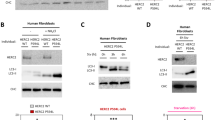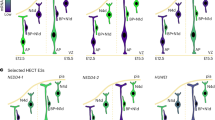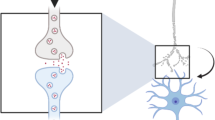Abstract
The ubiquitin-proteasome pathway is involved in the pathogenesis of several neurogenetic diseases. We describe a Mauritanian patient harboring a homozygous deletion restricted to two contiguous genes HERC2 and OCA2 and presenting with severe developmental abnormalities. The deletion causes the complete loss of HERC2 protein function, an E3-ubiquitin ligase. HERC2 is known to target XPA and BRCA1 for degradation and a mechanism whereby it is involved in DNA repair and cell cycle regulation. We showed that loss of HERC2 function leads to the accumulation of XPA and BRCA1 in the patient’s fibroblasts and generates decreased sensitivity to apoptosis and increased level of DNA repair. Our data describe for the first time the phenotypic consequences, both at the clinical and cellular levels, of a complete loss of HERC2 function in a patient. They strongly suggest that profound ubiquitin ligase – associated dysfunction is responsible for the severe phenotype in this patient, and that dysfunction of this pathway may be involved in other patients with similar neurodevelopmental diseases.
Similar content being viewed by others
Log in or create a free account to read this content
Gain free access to this article, as well as selected content from this journal and more on nature.com
or
References
Morice-Picard F, Lasseaux E, Cailley D et al: High-resolution array-CGH in patients with oculocutaneous albinism identifies new deletions of the TYR, OCA2, and SLC45A2 genes and a complex rearrangement of the OCA2 gene. Pigment Cell Melanoma Res 2014; 27: 59–71.
Ji Y, Rebert NA, Joslin JM, Higgins MJ, Schultz RA, Nicholls RD : Structure of the highly conserved HERC2 gene and of multiple partially duplicated paralogs in human. Genome Res 2000; 10: 319–329.
Kang T-H, Reardon JT, Sancar A : Regulation of nucleotide excision repair activity by transcriptional and post-transcriptional control of the XPA protein. Nucleic Acids Res 2011; 39: 3176–3187.
Kühnle S, Kogel U, Glockzin S et al: Physical and functional interaction of the HECT ubiquitin-protein ligases E6AP and HERC2. J Biol Chem 2011; 286: 19410–19416.
Wu W, Sato K, Koike A et al: HERC2 is an E3 ligase that targets BRCA1 for degradation. Cancer Res 2010; 70: 6384–6392.
Harlalka GV, Baple EL, Cross H et al: Mutation of HERC2 causes developmental delay with Angelman-like features. J Med Genet 2013; 50: 65–73.
Puffenberger EG, Jinks RN, Wang H et al: A homozygous missense mutation in HERC2 associated with global developmental delay and autism spectrum disorder. Hum Mutat 2012; 33: 1639–1646.
Rezvani HR, Dedieu S, North S et al: Hypoxia-inducible factor-1alpha, a key factor in the keratinocyte response to UVB exposure. J Biol Chem 2007; 282: 16413–16422.
Rezvani HR, Mahfouf W, Ali N et al: Hypoxia-inducible factor-1alpha regulates the expression of nucleotide excision repair proteins in keratinocytes. Nucleic Acids Res 2010; 38: 797–809.
Galligan JT, Martinez-Noël G, Arndt V et al: Proteomic analysis and identification of cellular interactors of the giant ubiquitin ligase HERC2. J Proteome Res 2015; 14: 953–966.
Brooks PJ, Cheng T-F, Cooper L : Do all of the neurologic diseases in patients with DNA repair gene mutations result from the accumulation of DNA damage? DNA Repair (Amst) 2008; 7: 834–848.
Garcia-Gonzalo FR, Rosa JL : The HERC proteins: functional and evolutionary insights. Cell Mol Life Sci 2005; 62: 1826–1838.
Lehman AL, Nakatsu Y, Ching A et al: A very large protein with diverse functional motifs is deficient in rjs (runty, jerky, sterile) mice. Proc Natl Acad Sci USA 1998; 95: 9436–9441.
Nguyen LS, Schneider T, Rio M et al: Mutation in HERC1 is associated with intellectual disability, megalencephaly, thick corpus callosum and cerebellar atrophy. Eur J Hum Genet 2016; 24: 455–458.
Mitchell DL : The relative cytotoxicity of (6-4) photoproducts and cyclobutane dimers in mammalian cells. Photochem Photobiol 1988; 48: 51–57.
Acknowledgements
The authors are grateful to the patient and his family for their participation in this study. This work was supported by Genespoir (French Albinism Association) by the Ministry of Health and by the Ministry of Research of France. Funding: This work was supported by Genespoir (French Albinism Association), by Union Nationale des Aveugles et Déficients Visuels (France), by the Ministry of Health and by the Ministry of Research of France. FMP had a PhD studentship from the Fondation pour la Recherche Médicale (France). Sanger DNA Sequencing was performed at the Genome Transcriptome Platform of Bordeaux (grants from the Conseil Régional d’Aquitaine no 20030304002FA and 20040305003FA and from the European Union, FEDER no 2003227).
Author information
Authors and Affiliations
Corresponding author
Ethics declarations
Competing interests
The authors declare no conflict of interest.
Additional information
Supplementary Information accompanies this paper on European Journal of Human Genetics website
Supplementary information
Rights and permissions
About this article
Cite this article
Morice-Picard, F., Benard, G., Rezvani, H. et al. Complete loss of function of the ubiquitin ligase HERC2 causes a severe neurodevelopmental phenotype. Eur J Hum Genet 25, 52–58 (2017). https://doi.org/10.1038/ejhg.2016.139
Received:
Revised:
Accepted:
Published:
Issue date:
DOI: https://doi.org/10.1038/ejhg.2016.139
This article is cited by
-
The gain-of-function UBE3AQ588E variant causes Angelman-like neurodevelopmental phenotypes in mice
Scientific Reports (2025)
-
Autophagy dysregulation via the USP20-ULK1 axis in the HERC2-related neurodevelopmental disorder
Cell Death Discovery (2024)
-
The immunogenetics of tuberculosis (TB) susceptibility
Immunogenetics (2023)
-
HERC2 deficiency activates C-RAF/MKK3/p38 signalling pathway altering the cellular response to oxidative stress
Cellular and Molecular Life Sciences (2022)



